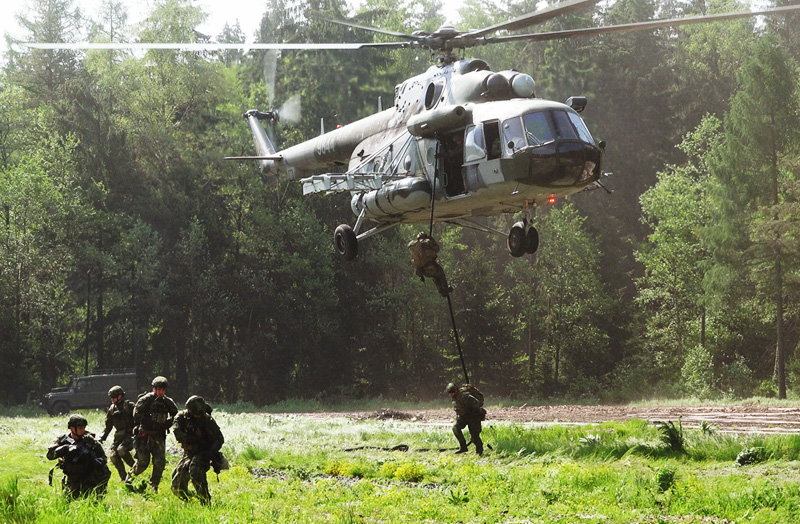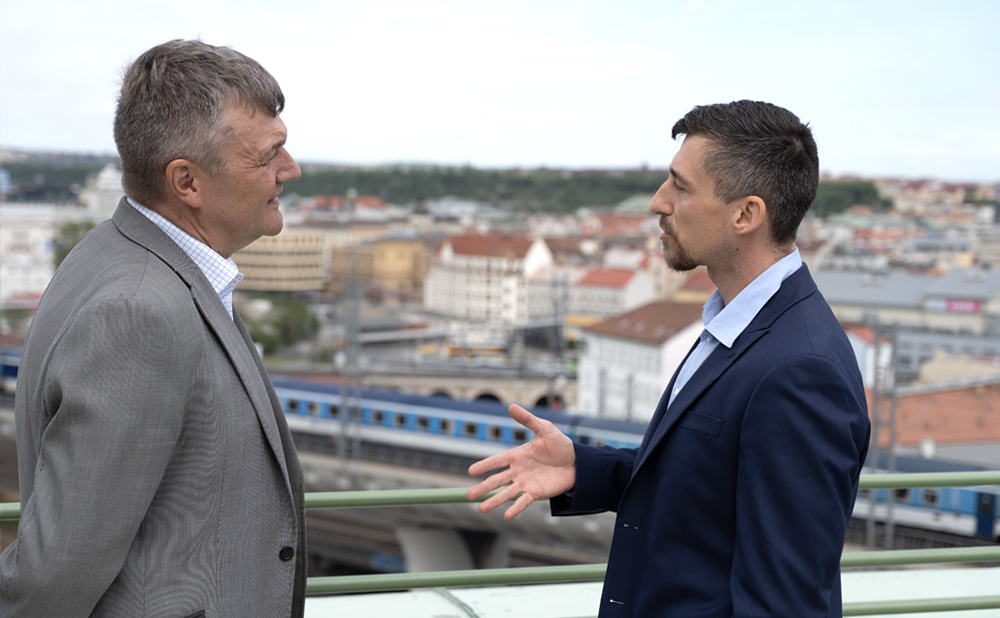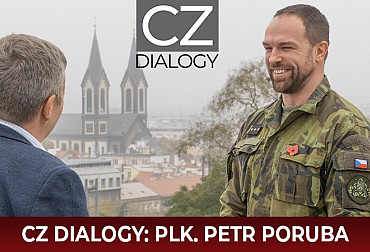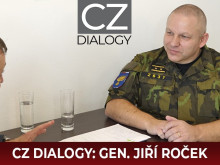Lieutenant Colonel Petr Matouš: Airborne regiment to be formed as a fast mobile force
We have already talked about the 43rd Airborne Regiment from Chrudim in our CZ DIALOGUES programme with the then commander Brigadier General Jiří Líbal, who now commands the 4th Rapid Deployment Brigade. The current commander of the 43rd Airborne Regiment is Lieutenant Colonel Petr Matouš, who we recently saw fighting at the Fighters for Veterans charity gala. This event in support of our war veterans eventually brought in an impressive 751,043 crowns to the Military Solidarity Fund. The paratroopers have always managed to draw attention to themselves not only by their combat results and abilities, but also by various events, such as the aforementioned Fighters for Veterans project, which we talked about, among other things, with Lieutenant Colonel Petr Matouš in the next episode of CZ DIALOGUES.
Video: Interview with the Commander of the 43rd Airborne Regiment Lieutenant Colonel Petr Matouš / CZ DEFENCE
The preparation for the gala took Petr Matouš almost a year, and he says the last three months have been very intense. Matouš's opponent was professional UFC fighter David Dvořák. The whole event could be watched live on TV. "A lot of people thought it was going to be a comedy. It wasn't a comedy. But you could see in David Dvorak that he didn't go all out in the first round. Otherwise, it probably would have been a quick process. He really is a top athlete," Petr Matouš recalls, adding that if this unique event were to become a traditional event, several changes would have to be made, such as the inclusion of foreign participants or the inclusion of another sport.
As a former deputy commander of the 43rd Airborne Regiment, Lieutenant Colonel Petr Matouš knows the workings of this manoeuvre element down to the smallest detail. As he says himself, no long speeches and recommendations had to be made during the transfer of command. The handover then took place in an unconventional way, by jumping. "Originally, we wanted to jump into the water together from a plane or helicopter. However, the jumps were cancelled that day, so we spontaneously got in the car and drove to Seč, where the Seč dam was unfortunately drained," Petr Matouš recalls, adding how they felt when the original depth for the jump of 9 metres ended up being more than 12 metres. However, the knife was lost on impact with the water. "But our divers found it at night and in the morning prepared it for him," adds Matthew.
An important parameter for the development of the 43rd Regiment's capabilities is the Concept of the Construction of the Army of the Czech Republic 2035, which does not change the tasks for the regiment's functioning, rather it is about the modernisation of armaments. "The airborne regiment is to be formed as a fast mobile force. First of all, there is talk about light assault vehicles, which will be supplemented. I must say for me that we have been working on this for a long time. Of course, it's also about weapons, and that's where the shoe is still on the other foot. We need to rearm the heavy machine guns and grenade launchers to western types. The truth is that the purchase of light assault vehicles is dragging on, the marketing survey was commissioned in 2020," says Lieutenant Colonel Petr Matouš in an interview, who believes that the paratroopers will eventually manage all the complications. "We are Czechs, so we can always cope. For us, the priority is the weapon and the vehicle, whatever it may be," adds the commander of the 43rd Airborne Regiment. The shift in purchases will not affect the unit's capabilities.

The war in Ukraine, as well as for other units of our army, has been a great lesson and a school in combat tactics. For paratroopers, it is especially about their use, where the controversial deployment of paratroop units on the Russian side is no surprise, according to Matthew. "You would expect that in an environment where there is strong air defence, the use of paratroopers would be a little bit different. If the airborne units, no matter how they are deployed, don't have enough logistics and support behind them, then they basically don't have much staying power on the battlefield," the 43rd Airborne Regiment commander said, adding: "We look at that, we analyse it and, of course, we adjust our training accordingly. But I have to say that this is not the only conflict we draw from. I wouldn't want to end up like we did in Afghanistan, where we redirected everything to so-called Afghanisation."
The war in Ukraine, however, has changed the existing training, because soldiers are not used to the so-called big war and to the classic offensive combat, defensive combat, delayed combat and other things that are now proving to be essential. "We were used to small expeditionary corps. But the mindset of the soldiers, and especially of the individual company commanders, we had to go back to preparing them for large maneuver warfare and for complex operations. In that situation, the company commander gets a lot of other elements around him that he has to exploit and fight with. Otherwise, of course, it is very difficult to survive on the battlefield," says Lieutenant Colonel Matouš.
Another very important topic related to this is recruitment. The Army has taken many steps over the past year in presenting itself and reaching out to potential recruits, but optimal staffing is a long-term challenge for almost all Army units. However, paratroopers could have a certain advantage in this matter. "Recruiting in general in the Army is a problem. We don't have the kind of manning that we imagine, so we are creating certain campaigns, trying to reach out to influencers, talking to people, going to schools, inviting them to our unit, which is such a novelty," explains Lieutenant Colonel Matouš. The results are gradually improving, he says, but there is another problem, which is the departure from the service into civilian life. Paratroopers are constantly devising new ways to motivate potential candidates to join the 43rd Airborne Regiment. The requirements for joining the paratroopers are still the same, but the form of motivation within the selection process is changing. "When we did the selection process x years ago, everyone wanted to get us out of the round. The difference now is that we try to motivate our new members at the selection process to finish the selection process," says Lieutenant Colonel Matouš.
A paratrooper must rely primarily on himself in combat, which is why the use of so-called modern technology is relatively limited. Currently, paratroopers use drones and, perhaps surprisingly, 3D printing. "A team from the University of Defence comes with us on exercises and we already have 3D printing in the field normally. If we need something printed quickly, we are able to help out and 3D print during an exercise or deployment. If we were talking about advanced technologies, like artificial intelligence and the like, we are not working with that yet," says Lieutenant Colonel Petr Matouš. Advanced technologies certainly include navigation systems and other targeting devices used by reconnaissance specialists or snipers. However, in other companies or commands, you won't find anything exceptional in a soldier's equipment.
Since commando was mentioned, we wondered why paratroopers have commandos and the rest of the army has squads. "We have a squad too. The commando is basically an augmented company. The difference is not that we don't have squads or platoons. We have classic squads and classic platoons like elsewhere, except the company has its own separate self-support, it has a small element of drones and intelligence support, it's augmented, and that's why it's called a commando, as a kind of strike force," explains the 43rd Airborne Regiment commander.

It is said that the paratroopers are a tight-knit community that does not end even by going into civilian life. Paratroopers then almost always go on to join the active reserves after leaving active duty. "For us, the active reserves are absolutely amazing. I have to say the fill rate is over ninety percent. Sometimes it amazes me how big-hearted they are," says Lieutenant Colonel Matouš. It is no surprise that reservists from the 43rd Airborne Regiment are often deployed in NATO missions. "We have our reservists for dual use. We can use them as a fifth commando on their own, but on the other hand we also need them to supplement our forces in case of any losses or other needs. We use them absolutely standard on exercises. We've implemented them among the pros, which we haven't done that often in the past. They come with us on foreign exercises. It is absolutely common and they have implemented themselves very well into our structures," Lieutenant Colonel Matouš added.
We asked what is the most common reason for a professional paratrooper to go into civilian life? "Very often it is health, but it is also seniority. It's not just about parachuting, but it's also a lot of hard work and sweat in the woods. They carry really heavy packs. Training is not easy and you just can't do it forever," says Lieutenant Colonel Petr Matouš.
During the interview with the commander of the 43rd Airborne Regiment, we further discussed what the paratroopers lack in their equipment, whether training with the new H-1 helicopters is already underway, how the paratroopers are looking forward to the new C-390 Millennium transport aircraft or what Lieutenant Colonel Matouš's ambitions are for the future as the regiment commander. To learn more, listen to the full interview at the top of this article.





















